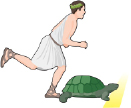Lesson 5: Integral Exponents
Module 2: Roots and Powers
 Lesson Assessment
Lesson Assessment
Complete the lesson quiz posted under the Assess tab or by using the Quizzes link under the Activities block. Also, ensure your work in your binder (course folder) is complete.
 Project Connection **NOT ASSIGNED**
Project Connection **NOT ASSIGNED**

© Andrea Danti/shutterstock
There are reasons for the use of encryption other than security. In some cases, a code is developed in order to relay messages in a more practical manner. Morse code, for example, is a code that makes use of rhythms to transmit information. Letters and numbers in Morse code are based on particular sequences of dots and dashes. As a result, you would only need two input signals to communicate with Morse code, not 36 keys—the minimum you would need on a keyboard to communicate all the alphanumeric characters.
In this section you will look at a coding system similar to Morse code but that is used by computers. The information inside a computer is coded using binary numbers. All the data a computer stores and uses to run applications is based on the binary number system that only uses the digits 0 and 1. Just as the decimal number system you use every day is based on powers of 10, the binary number system is based on powers of 2.
Here is how you can count to 10 in binary:
0000
0001
0010
0011
0100
0101
0110
0111
1000
1001
1010
You can get an idea for how binary works by comparing it to the decimal system:
In the decimal system the position of each digit corresponds to a power of 10. For example,
|
102 |
101 |
100 |
Expansion |
Number in Base 10 |
|
2 |
9 |
(2 × 101) + (9 × 100) |
29 |
|
|
1 |
1 |
4 |
(1 × 102) + (1 × 101) + (4 × 100) |
114 |
In the binary system the position of each digit corresponds to a power of 2. For example,
|
27 |
26 |
25 |
24 |
23 |
22 |
21 |
20 |
Expansion |
Number in Base 2 |
Number in Base 10 |
|
1 |
1 |
1 |
0 |
1 |
(1 × 24) + (1 × 23) + (1 × 22) + (1 × 20) |
11101 |
29 |
|||
|
1 |
1 |
1 |
0 |
0 |
1 |
0 |
(1 × 26) + (1 × 25) + (1 × 24) + (1 × 21) |
1110010 |
114 |
At this time, go to the Unit 2 Project and complete the Module 2: Lesson 5 portion of the project.
 Going Beyond
Going Beyond
In the Discover section of this lesson you repeatedly cut a stick of licorice in half. Theoretically, you can never eat the entire licorice because there would always be a small piece left. Yet it seems like you should be able to eat all the licorice at some point. When a group of statements seems to contradict each other or defies intuition, those statements represent a paradox.

The ancient Greek philosopher Zeno of Elea posed a series of problems known as Zeno’s paradoxes. The most famous of these paradoxes involves the Greek hero Achilles and the tortoise. In it, Achilles challenges the tortoise to a footrace. Achilles is so confident of winning that he gives his opponent a 100-m head start. By the time Achilles runs 100 m, the tortoise has moved another 10 m. By the time Achilles makes up the 10-m distance, the tortoise has advanced another 1 m. This scenario repeats itself with the tortoise advancing one-tenth of its previous move each time Achilles reaches its previous marker. If this continues, Achilles will never catch the tortoise. Yet experience shows that in these cases, the faster runner should win. The paradox lies in the seeming contradiction of the last two statements.
Here are some ideas for further research:
- There are paradoxes in many disciplines including logic, physics, languages, and mathematics. See if you can identify other examples of paradoxes.
- If you started with $200, then added $100, then added $50, and so on indefinitely, how much would you have? (The answer is not an infinite amount of money.)